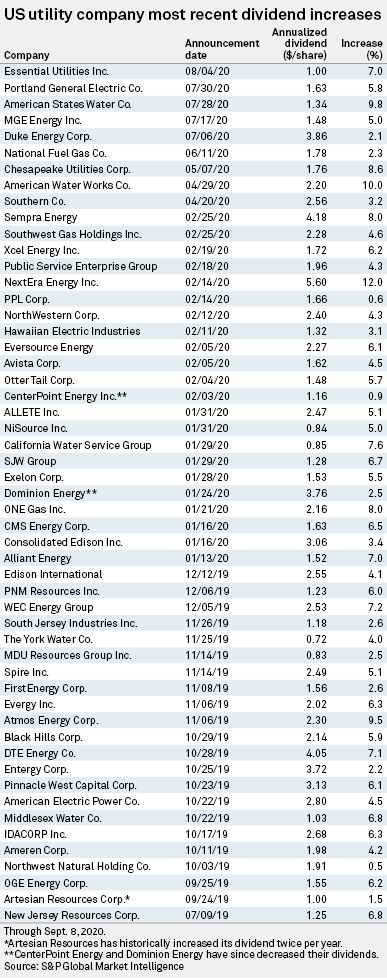Utility dividend growth thus far this year has kept pace with 2019 despite the ongoing coronavirus pandemic. Year-to-date, 31 energy and water utilities have increased their dividends, compared to 32 utilities over the same period in 2019. Two utilities — CenterPoint Energy, Inc. and Dominion Energy, Inc. — have reduced their dividends after increasing their dividends earlier this year.
Only one utility, New Jersey Resources Corporation, has gone more than 12 months without a dividend increase. New Jersey Resources last increased its dividend by 6.8% in July 2019. On the company's fiscal third quarter earnings conference call, CFO Patrick J. Migliaccio stated that the company does not expect changes in its annual long-term dividend growth rate target of 6% to 8%.
During September through December 2019, 21 utilities increased their dividend. Looking ahead to potential near-term dividend bumps, OGE Energy Corp., which is a co-owner of Enable Midstream Partners with CenterPoint Energy, last increased its dividend on Sept. 25, 2019.

Energy and water utility dividend increases thus far in 2020 have averaged about 5.5%, with NextEra Energy Inc. leading the group with a 12% increase and PPL Corp. lagging the group with a 0.6% increase. According to an analysis of paid dividends, the average increase in paid dividends in 2019 was 5.6%, below the 2018 and 2017 average increases of 6.4% and 6.8%, respectively. The average utility dividend payout ratio in 2019 was 62.8%, above the 2018 and 2017 average payout ratios of 60.8% and 61.3%, respectively.
Historically, U.S. regulated utility dividend cuts have been infrequent, only occurring during times of significant distress. For example, PG&E Corp. suspended its dividend in December 2017 on potential liabilities associated with California wildfires. Generally, companies with high payout ratios have opted to gradually reduce those ratios over time, instead of slashing or suspending dividends.
In January, Dominion Energy announced a 2.5% dividend increase to an annualized rate of $3.76 per share. In July, following revelations that the company was selling its gas transmission and storage assets and abandoning the Atlantic Coast natural gas pipeline project, Dominion reduced its 2020 earnings guidance to a range of $3.37 to $3.63 per share, from the previous range of $4.25 to $4.60 per share. Dominion also indicated a new dividend payout ratio target of 65% upon completion of the gas transaction, which would imply an annualized dividend rate of $2.50 for 2021.
In February, CenterPoint Energy announced a 0.9% dividend increase to an annualized rate of $1.16 per share. In April, Enable Midstream Partners, in which CenterPoint owns a substantial interest, cut its quarterly distribution by 50% and its planned 2020 expansion capital expenditures by $115 million. In response, CenterPoint reduced its own quarterly dividend by 48% to an annualized rate of 60 cents per share and its planned 2020 capital expenditures by $300 million.
With an average 2019 payout ratio of 56.2%, the small investor-owned water utility sector appears to have room to continue their annual dividend increases, despite coronavirus overhang. Excluding American Water Works Co. Inc., which had its initial public offering in 2008, the remaining seven water utilities have increased their dividend payments annually for over 20 years.

Regulatory Research Associates is a group within S&P Global Market Intelligence.
For a complete, searchable listing of RRA's in-depth research and analysis, please go to the S&P Global Market Intelligence Energy Research Library (subscription required).
This article was published by S&P Global Market Intelligence and not by S&P Global Ratings, which is a separately managed division of S&P Global.



